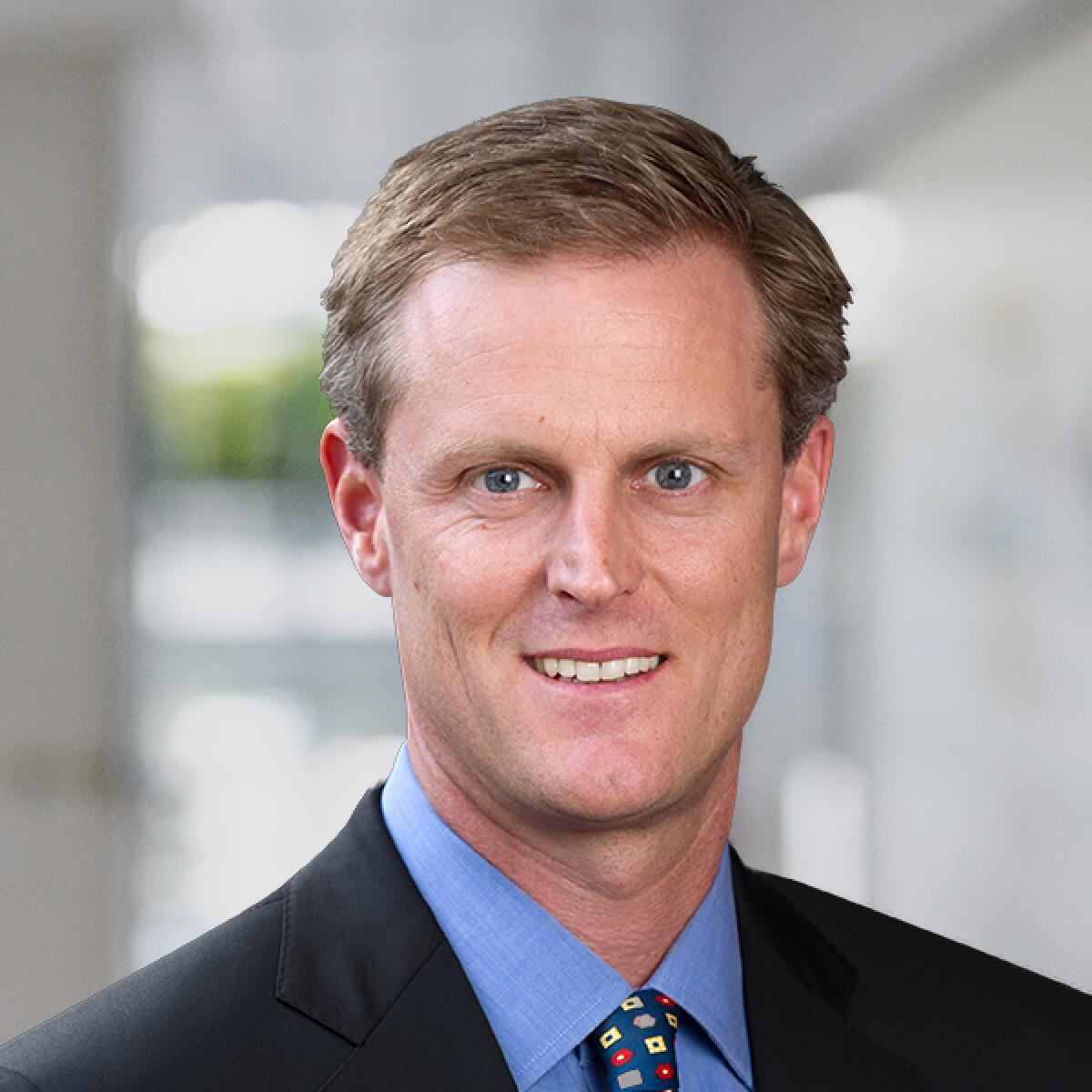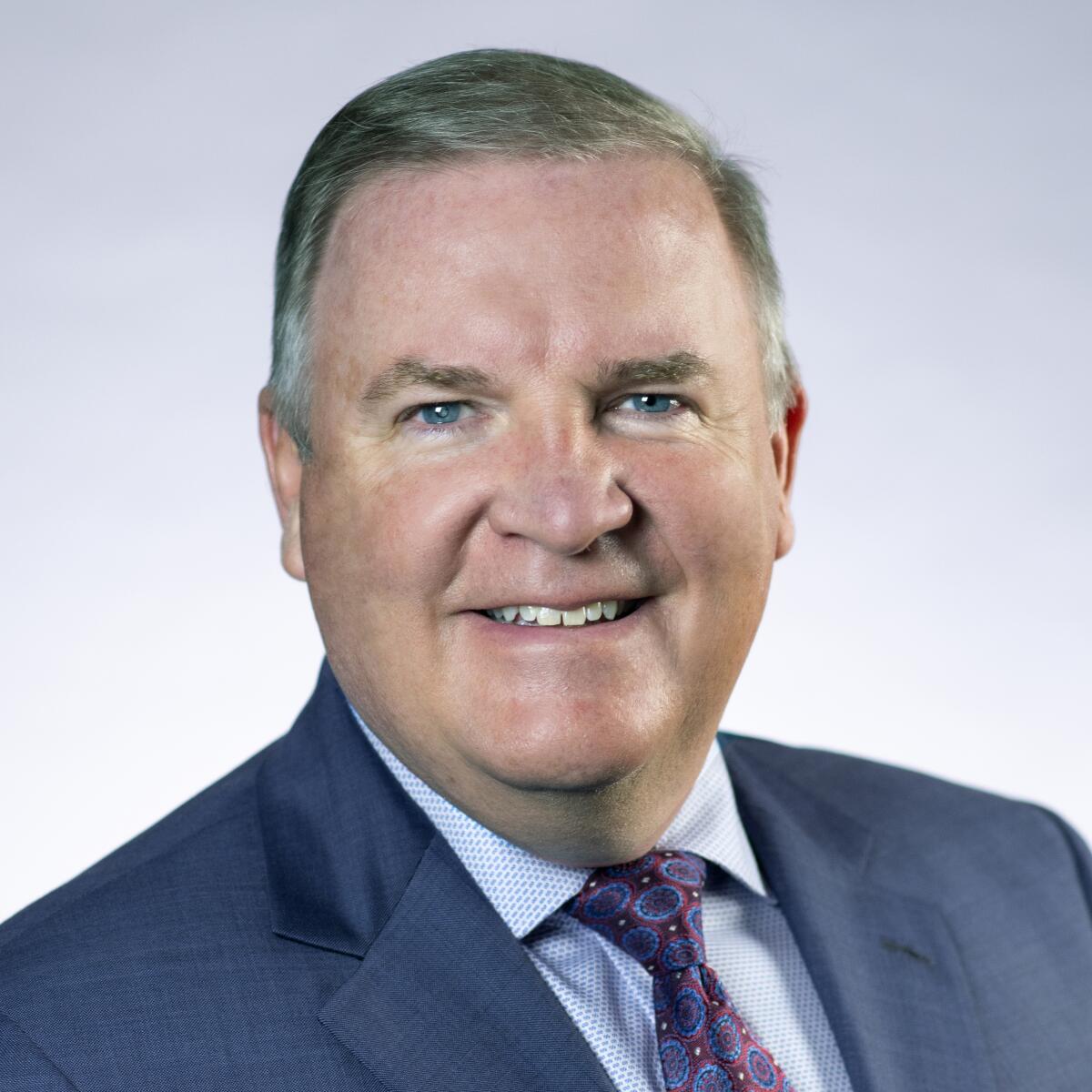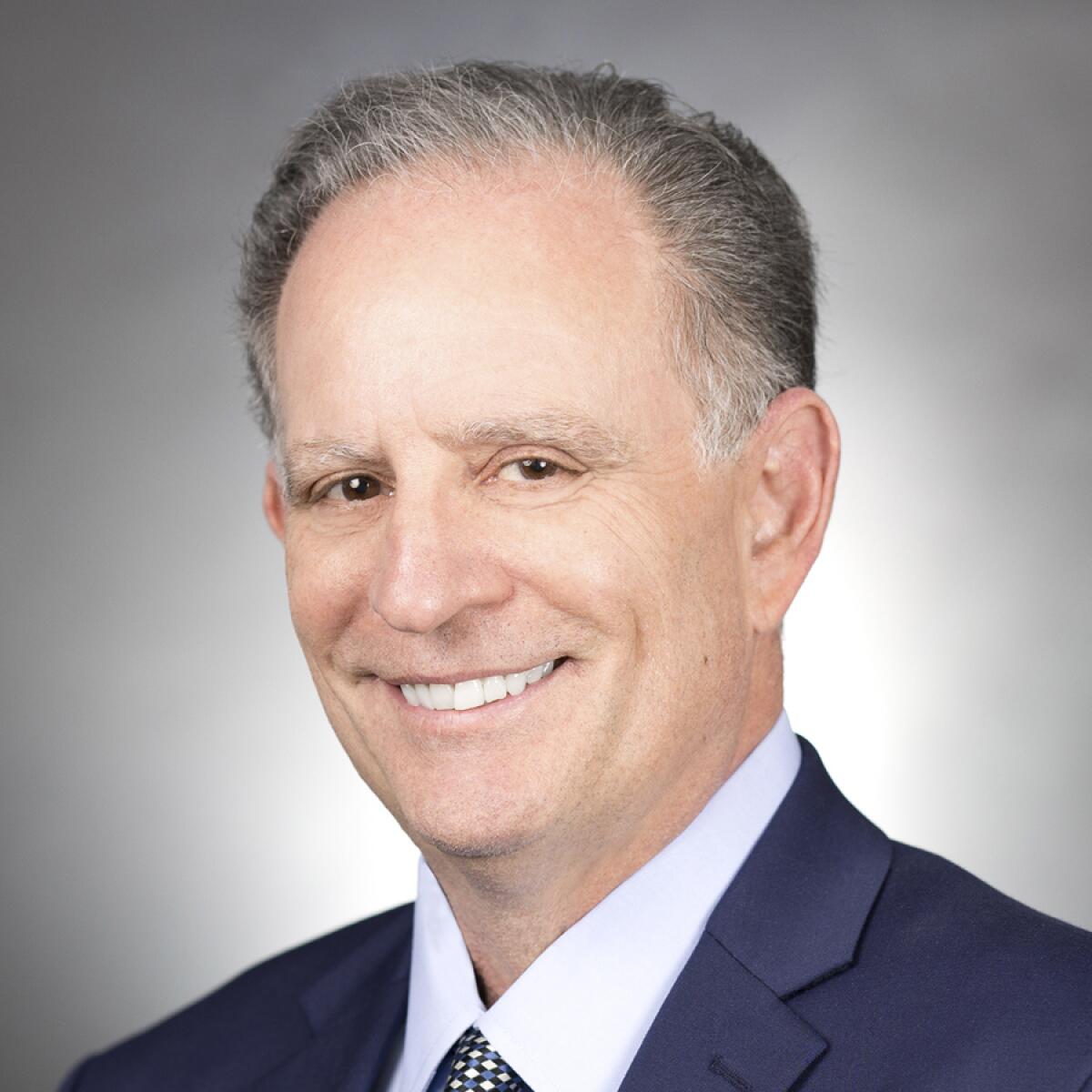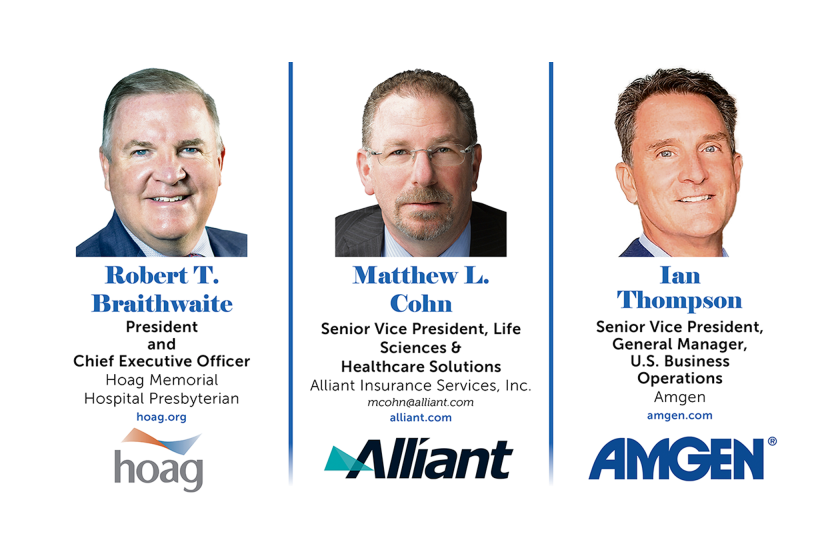Robert T. Braithwaite, Channing Hamlet and Daniel A. Platt Share Insights on the Healthcare, Biotech and Life Sciences Landscape in 2024
- Share via
The Healthcare, Biotech & Life Sciences Roundtable panel is produced by the L.A. Times B2B Publishing team in conjunction with Hoag Memorial Hospital Presbyterian; JAMS; and Objective, Investment Banking & Valuation.
Treatment modalities and care best practices aside, the healthcare business sector - perhaps more than any other category of industry - has been forced to reassess, restructure and remodel itself to accommodate the unpredictable times we have faced over the last few years due to unprecedented changes and challenges.
Decision makers in the healthcare, biotech and life sciences space continue to be faced with a number of challenging questions, yes, but it appears that many of the answers to those questions, and many of health’s latest solutions, come in the shape of new technological innovations. Are the advancements that came about due to necessity here to stay? And what about telemedicine and how it has changed the treatment landscape? What other innovations are on the horizon?
To take a closer look at the latest trends and modalities in the business of healthcare, biotech and life sciences, we have turned to three of the region’s leading experts who graciously weighed in for a discussion and shared insights from three diverse perspectives on the state of healthcare in 2024.
Q: What should medical device, pharma and biotech companies be focused on in 2024?

Channing Hamlet, Founder & Managing Director, Objective, Investment Banking & Valuation, objectiveibv.com: Our firm primarily advises companies that provide software and services for the device, pharma and biotech markets. Given that these industries face mounting pressure to accelerate time-to-market while managing costs, outsourcing critical functions like R&D, clinical trials, manufacturing and sales/marketing has become indispensable. As a result, we have seen a number of specialized service providers develop significant expertise in marketing, clinical research, regulatory compliance and data management. Many of these companies bring core competencies in technology, automation, AI and other areas that are outside of the core technical expertise resident within the device, pharma and biotech sectors. As a result, many of these companies that bring strong capability are experiencing strong growth. Despite inflation and higher interest rates, these trends continue to support strong growth within the services/software areas, significant investment and M&A activity, and strong valuations.
Q: Is healthcare technology keeping up with demand?

Robert T. Braithwaite, President and CEO, Hoag Memorial Hospital Presbyterian, hoag.org: Healthcare technology is rapidly advancing to meet the increasing demand for long-term wellness, and at Hoag, we anticipated this demand and the desire to address concerns proactively and comprehensively by launching a series of personalized, tech-enabled approaches to care. Innovations in genomics, virtual care and AI are driving the development of comprehensive and personalized care models. Hybrid virtual/physical care approaches are now incorporating extensive lab testing, built-in health coaching and more frequent diagnostics, highlighting a shift towards integrated and anticipatory health systems. Each technological advancement not only elevates patient expectations but also pushes the boundaries of healthcare delivery, making it imperative for the sector to keep pace. The integration of advanced technologies into routine care is setting a new standard, where healthcare providers are increasingly focusing on preemptive measures rather than reactive treatments. As a result, the healthcare industry is witnessing a paradigm shift towards more efficient, patient-centered care models. This shift underscores the need for continuous innovation and adaptation to ensure that healthcare systems can effectively respond to and anticipate patient needs, ultimately leading to better health outcomes and more sustainable healthcare practices.
Q: What new legal or regulatory considerations should healthcare-related organizations be aware of?

Daniel A. Platt, Esq., Arbitrator, Mediator, Special Master/Referee, JAMS, jamsadr.com: The No Surprises Act has not only limited reimbursement rates for emergent services, but the rules regarding arbitration limit the ability to present a case. Hearings are dramatically truncated and there is no process by which a party can appeal. It is too soon to know if this will have any impact on other aspects of healthcare litigation, but it is worth watching.
Q: What are some of the biggest current trends in the pharmaceutical industry?
Hamlet: Pharmaceutical companies continue to focus on strategic outsourcing to enhance innovation and efficiency. The complexity of research and development continues to escalate with the advent of personalized medicine, advanced genetics and AI-driven solutions. To navigate these challenges, companies are increasingly turning to third-party service providers. Outsourcing critical functions such as R&D, clinical trials and manufacturing to Contract Research Organizations (CROs) and Contract Development and Manufacturing Organizations (CDMOs) enables firms to leverage specialized expertise and cutting-edge technologies offering solutions that align with the fast-evolving industry demands, reducing operational burdens and allowing companies to focus on their core competencies. As the industry seeks novel solutions to address rising healthcare costs, the role of external partners in driving research, development, and commercialization will be paramount. The biotech and pharmaceutical sectors in 2024 will thrive on a robust ecosystem of outsourcing partnerships, fostering growth and groundbreaking advancements in healthcare.
Q: What are some of the most exciting innovations you are seeing in the healthcare sector today?
Braithwaite: Innovations in healthcare are creating a deeply personalized and emotionally supportive patient experience, empowering individuals to take charge of their wellness. Advanced tools and technologies are enabling early disease detection and the development of precise, targeted treatment plans. For instance, Hoag is the first hospital on the West Coast to offer the VECTRA WB360 whole-body 3D imaging system, which is revolutionizing early skin cancer detection. This technology, combined with Hoag physicians’ advanced screening methods, shifts the patient experience from one of fear to confidence, ensuring early detection of melanoma with minimal impact on life. This change in mentality from “when not if” to proactive management is profoundly impactful for patients. Beyond technological innovations, the healthcare sector is experiencing significant demand driven by three major factors: the need for convenient access to acute care, the rise of at-home care solutions and the focus on long-term preventative wellness, which is becoming the future of primary care. Innovations in inpatient and outpatient diagnostics and surgeries are also transforming healthcare delivery. These include minimally invasive surgical techniques and advanced imaging technologies that improve diagnostic accuracy and patient recovery times. These innovations are creating an ecosystem of highly personalized healthcare offerings, where patients are increasingly involved in their own health management, which leads to improved health outcomes and a more responsive healthcare system, addressing the diverse needs of patients across different care venues.
I think the next big thing in healthcare is going to be the disruption of the pharmacy benefit management (PBM) industry. There are new big players coming into the market, and the only constant will be constant change.
— Daniel A. Platt, Esq.
Q: What specific healthcare innovation verticals do you see rising in California and the life science industry as a whole?
Hamlet: In California and the broader life sciences industry, we see a significant rise in healthcare innovation verticals such as telemedicine, personalized medicine, biotechnology and health data analytics. Companies providing services in these areas are becoming increasingly impactful as they address critical needs for more efficient, personalized and data-driven healthcare solutions. These life sciences and healthcare services firms are attracting higher valuations and more unsolicited interest from acquirers due to their potential to revolutionize patient care, reduce costs and enhance clinical outcomes. As these services become integral to the healthcare ecosystem, their strategic importance and market value continue to escalate, making them prime targets for M&A activity.
Platt: I think the next big thing in healthcare is going to be the disruption of the pharmacy benefit management (PBM) industry. There are new big players coming into the market (such as Amazon and the Mark Cuban Cost Plus Drug Company), and the only constant will be constant change. Right now, even those insureds who have a low-deductible plan are paying higher premiums due to the high cost of prescription medication. If these new players can bring down costs, it will likely lead to a decrease in premiums as well.
Q: What key attributes do private equity firms seek in targeting healthcare, biotech, and life science companies for acquisition?
Hamlet: Private equity (“PE”) firms are increasingly attracted to the healthcare, biotech and life sciences industries due to their resilience against economic cycles. Attributes that PE firms prioritize include: (a) Stability and Growth Potential: Companies that demonstrate consistent revenue growth and have a solid track record of performance are highly attractive. The ability to withstand economic downturns and maintain steady growth is a crucial factor. (b) Service and Software Focus: Companies that provide essential services and software solutions within the healthcare ecosystem are less vulnerable to regulatory changes and scrutiny, making them reliable investment targets. (c) Regulatory Compliance and Low Risk: PE firms typically avoid companies with high science risk. Instead, they favor businesses with well-established products, services and technology. (d) Specialization and Expertise: Many PE firms seek companies with specialized knowledge and capabilities that align with their strategic focus areas, ensuring they can add value and drive growth post-acquisition.
Q: What is the future of AI and machine learning in the healthcare, biotech and life sciences industries?
Braithwaite: AI is becoming a valuable asset in healthcare technology, enhancing everything from surgical procedures to hospital operations. AI-powered systems can now analyze complex medical data, leading to early and more precise disease detection, which is crucial for successful treatment outcomes. It is particularly beneficial in radiology, where it accelerates detection processes, and in administrative functions such as billing and communication. However, the integration of AI must be approached with caution due to potential cybersecurity risks and inaccuracies. A careful, case-by-case adoption strategy ensures that AI is used effectively and responsibly to solve specific healthcare challenges, thereby improving the overall healthcare landscape. The incorporation of AI into clinical workflows is transforming the way healthcare is delivered, making it more efficient and precise. For example, AI algorithms can analyze medical images much faster and with greater accuracy than traditional methods, leading to quicker diagnoses and treatment plans. Additionally, AI-powered tools are being used to streamline hospital operations, from patient triaging to resource management, ensuring that healthcare facilities run more smoothly and efficiently. Despite these advancements, it is crucial to remain vigilant about the ethical implications of AI in healthcare, ensuring that it is used to enhance, rather than replace, the human element of patient care. By maintaining a balanced approach, the healthcare industry can leverage AI’s full potential while safeguarding against its risks. At Hoag, we are focused on identifying where AI can help identify and solve problems that, once alleviated, create a better healthcare landscape for Orange County.
As the industry seeks novel solutions to address rising healthcare costs, the role of external partners in driving research, development and commercialization will be paramount.
— Channing Hamlet
Q: What are some of the biggest mistakes that healthcare industry organizations are making today?
Platt: Healthcare is a very specialized, highly regulated and constantly changing industry. It is critical for the stakeholders to do everything in their power to make sure that experienced professionals are deciding complex business disputes. As a result, all health care contracts should require arbitration with a neutral who has specific and reference experience so the parties can make sure that the trier of fact will understand the issue and the relevant landscape.
Hamlet: One of the biggest mistakes healthcare organizations make today is mismanaging unsolicited acquisition interest. Many fail to adequately prepare for potential offers, missing opportunities to maximize value. Companies often lack a clear strategy for evaluating and responding to unsolicited bids, leading to rushed decisions and suboptimal outcomes. Additionally, healthcare organizations sometimes overlook the importance of operational efficiency and cost management, focusing too narrowly on growth without optimizing internal processes. Neglecting patient-centric innovations and failing to adapt to regulatory changes can also diminish value. To avoid these pitfalls, organizations should proactively develop M&A strategies, enhance operational efficiencies, and stay attuned to market and regulatory shifts. Valuation reports and industry expert valuation advisors, like those at Objective, can provide critical insights to help navigate these challenges.
Q: How about the insurance landscape? What changes are you seeing there?
Platt: The health insurance industry is consolidating both vertically and horizontally. The carriers will continue to merge and to acquire other healthcare-related businesses, such as urgent care centers, pharmacies and PBMs. While this may result in fewer choices, I expect it will also help to rein in costs.
Q: How will virtual care and/or telemedicine affect the healthcare landscape moving forward?
Braithwaite: Virtual care and telemedicine are foundational to a proactive approach to long-term health. The logical extension of this approach is to bring healthcare directly into people’s homes, and Hoag is leading a national movement to do just that. They bring healthcare directly into patients’ homes, facilitating faster recovery and greater convenience. The concept of home-based medical services is gaining traction, supported by evidence that patients recover more effectively in familiar environments surrounded by loved ones. Virtual care’s growing popularity indicates a strong patient preference for convenient, high-quality healthcare, which can be effectively delivered through these emerging models. The integration of telehealth into routine care practices is revolutionizing the healthcare landscape, making it more accessible and patient-centered. Patients can now receive medical consultations, follow-ups and even certain treatments without leaving their homes, reducing the need for hospital visits and minimizing the risk of exposure to infectious diseases. Furthermore, telemedicine allows for continuous monitoring of chronic conditions, enabling healthcare providers to offer timely interventions and personalized care plans. This shift towards virtual care is not only enhancing patient satisfaction but also improving health outcomes by making healthcare more accessible and responsive. As technology continues to advance, we can expect virtual care to play an increasingly significant role in shaping the future of healthcare, providing patients with more choices and greater control over their health.
Q: What are the benefits of Alternative Dispute Resolution (ADR) and when do you recommend using it?
Platt: ADR is critical in the healthcare industry. I believe that it is the best way to establish that the finder of fact and law has the appropriate skill set, and in California, it is the only way to waive a jury trial. It also provides the parties with an opportunity to set up the rules for how the dispute is litigated in terms of, among other things, discovery, motion practice and the evidentiary hearing.
Q: What specific trends are you seeing in relation to ADR?
Platt: One of the key advantages of ADR is control of the process, and the arbitration provisions in the cases I am seeing are becoming more robust in that regard. For example, the parties are controlling the process for dispositive motions, how much discovery is permitted and whether the rules of evidence will apply in motions and at the evidentiary hearing. I have also seen matters where the parties select a certain type of process, such as baseball-style arbitration. There is no limit to how an arbitration provision can be structured, and the trend is toward more customization.
It is crucial to remain vigilant about the ethical implications of AI in healthcare, ensuring that it is used to enhance, rather than replace, the human element of patient care.
— Robert T. Braithwaite
Q: What is the current state of M&A in the healthcare, biotech, and life science industries?
Hamlet: Dealmakers in these three industries are eager to get deals done in 2024 as they grow more comfortable navigating an environment of elevated interest rates and regulatory pressure. Demand for GLP-1 drugs for type 2 diabetes and weight loss has spurred significant M&A activity, including Roche’s acquisition of Carmot Therapeutics and Novo Nordisk’s proposed $16.5B acquisition of Catalent. These deals address GLP-1 supply shortages rather than indicating a broader industry trend. In 2023, biopharma M&A activity rebounded with a total deal value of around $152B, the highest since 2019. PwC predicts that deal totals in 2024 could range from $225B to $275B. As of December 2023, M&A investment in the global life sciences industry totaled $191B, up from $142B in 2022, driven by strong capital reserves and the pursuit of new revenue streams. This data underscores a dynamic and competitive M&A environment across these industries.
Q: Looking to the future, what healthcare-related trends do you think we can expect to come along within the next five years?
Braithwaite: In the next five years, expect significant strides in bringing high-quality care to communities with an emphasis on healthy aging, whole-body wellness and multidisciplinary collaboration. The integration of personalized, community-based approaches with cutting-edge medical practices will likely become more prevalent. This approach combines access to renowned specialists and clinical trials with tailored healthcare services, addressing the evolving needs of diverse populations. The trend towards what we call a “privademic” model - one that combines the commitment to research found at an academic institution with the patient-centered, compassionate care of a community hospital - will likely drive the recruitment of top physicians and the advancement of specialized services, ensuring comprehensive and forward-thinking healthcare delivery. Healthcare providers will increasingly focus on preventative measures, promoting overall wellness rather than solely treating illnesses. We will also likely see a greater emphasis on mental health and the integration of mental and physical health services, recognizing the importance of holistic care. Overall, these trends will contribute to a more patient-centered, efficient and responsive healthcare system that is better equipped to meet the needs of a diverse and aging population. I think this approach will fuel our ability to identify and meet the evolving needs of our community and recruit top-ranked physicians across Hoag’s specialized services in areas including cancer, neurosciences, heart and vascular, digestive health, spine and women’s health.
Platt: I think the next big thing will be digital medical records (DMRs). DMRs provide accurate, up-to-date and complete information at the point of care, enabling more efficient care by aiding in sharing information. This leads to more effective diagnoses and better treatment. Ultimately, this should reduce costs through efficiency, streamline medical care and drive down costs.

